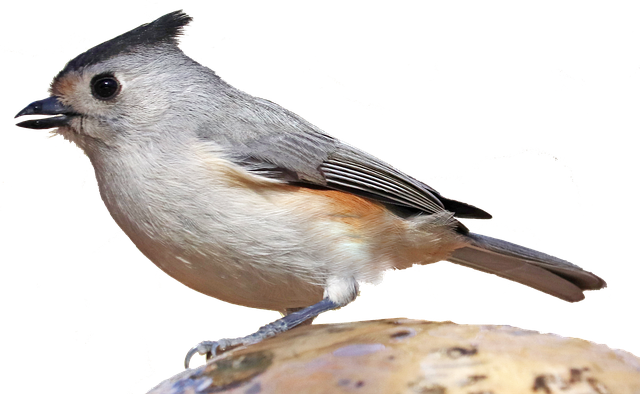Einstein once said, “Look deep into nature, and then you will understand everything better.” Well, from my tiny perch up here in the canopy, I’m not sure about everything, but I certainly see the world from a different angle. I’m what ornithologists call a Tufted Titmouse—Baeolophus bicolor —though I’ve always thought “titmouse” was one of the more peculiar naming decisions your species has made. I’m no mouse, and I’ve got nothing to do with any mammalian features that might come to mind.

My crest—that jaunty little tuft on my head—is like a punctuation mark for my personality. It stands up when I’m alert, lays flat when I’m calm, and sometimes, I’ll admit, I use it for dramatic effect. When I’m giving my signature “peter-peter-peter” call, the crest adds a certain visual flair that I think makes the whole performance more compelling. Shakespeare wrote about “this brave o’erhanging firmament,” but my crest is my own personal firmament, announcing my moods to the world.
I live in the deciduous and mixed forests of the eastern United States, year-round. No migration for me—I’m what you might call a committed local. While others abandon ship when winter sets in, I stay put, forming loose flocks with chickadees, nuthatches, and the occasional downy woodpecker. We’re like a small-town council, each bringing our own expertise to the survival of the neighborhood.
Memory—now there’s a philosophical puzzle wrapped in feathers. I’m blessed (or cursed, depending on how you look at it) with a remarkable one. During autumn, I scatter-hoard food, stashing thousands of seeds in bark crevices, under leaves, anywhere I can wedge them. And here’s the thing—I remember where they are, months later. Your neuroscientists have studied this, finding that my hippocampus actually grows larger in fall to accommodate all this spatial information. The poet Mary Oliver wrote about paying attention being “our endless and proper work.” For me, it’s not just proper—it’s essential for survival.
My diet is eclectic: insects in summer, when I’m feeding nestlings, and seeds in winter, when the invertebrate buffet closes for the season. I’ve got a particular fondness for your black oil sunflower seeds—there’s something about them that feels indulgent, like your species’ version of chocolate. At your feeders, I’m the one who grabs a seed and immediately flies away to crack it against a branch. I hold it with my feet and hammer at it with my bill. Some might call this behavior skittish; I prefer to think of it as prudently cautious with a side of efficiency.
Pair bonding—now there’s something humans could learn from us. We mate for life, or at least until one of us runs out of life, which tends to be the more accurate way of putting it. During courtship, I offer my chosen one delicate morsels of food, and she assesses my worthiness based on the quality of my offerings. It’s not unlike your dinner dates, really, just with more immediate nutritional benefits and less small talk.
Our nests are a study in adaptive engineering. We’ll use natural cavities, old woodpecker holes, even nest boxes when available. The female does most of the construction—a cup of moss, leaves, and bark strips, lined with hair or fur. And here’s where things get interesting: we’ve been known to pluck hair directly from living animals. Raccoons, squirrels, even dogs—we’re equal opportunity barbershops. Once, I watched a bold female pluck fur from a sleeping cat’s tail. The cat woke up, but by then she was already gone, a whisper of wings and a tuft of fur richer.
We typically lay five to eight eggs, white with reddish-brown speckles. Both parents feed the nestlings, and here’s something remarkable—I don’t just feed my own. Sometimes I’ll help feed my siblings’ broods or even the offspring of unrelated pairs. Biologists call this “cooperative breeding,” but I think of it as the embodiment of that African proverb: “It takes a village to raise a child.”
In the hierarchy of avian intelligence, we titmice rank surprisingly high. We’ve been observed using tools, solving problems, and even engaging in what seems suspiciously like play. I once spent an entire afternoon figuring out how to extract seeds from a particularly challenging feeder design. The satisfaction when I finally cracked the code was profound—like solving one of your Sunday crossword puzzles.
My alarm calls aren’t just simple warnings; they contain information about the type and location of the threat. A flying predator gets one call, a perched hawk another, and a snake yet another. Your linguists might say I’ve developed a primitive language, though I prefer to think of it as efficient crisis communication. When other species hear my calls, they pay attention. I’m the neighborhood watch with wings.
As the light lengthens toward spring, something stirs in me—an ancient knowledge encoded in my very cells. My song becomes more complex, more insistent. Territory must be established, a mate courted, a nest built. The cycle continues, as it has for millennia before me and will (one hopes) for millennia after.
You humans, with your calendars and clocks, think you’ve mastered time. But from where I perch, watching the seasons wheel overhead, I know that time masters us all. We’re just notes in a grand symphony, each playing our part until our measure is done. As Thoreau observed, “Time is but the stream I go a-fishing in.” And I, with my gray back and white belly, my black forehead and proud crest, am both the fisherman and the fish, casting my voice into the morning and catching what moments I can.